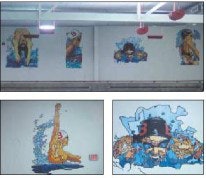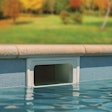
Baseball, Hot Tubs and Apple Pie
Brewers try to raise fan morale with hot tub.
Fans attending a Milwaukee Brewers game this year at Miller Park have more than just beer, hot dogs and peanuts to look forward to — now they can consume all the ballpark treats they want in the new eight-person HotSpring Grandee Spa in the stadium's grandstands.
And the first time a Brewers' player hits a home run that lands, on-the-fly and without human interference, in the spa, all fans in attendance will receive one free ticket to another game. For any further fly balls hit into the spa, one fan in attendance will receive a $1,000 cash prize.
And that's not all. If a Brewers' player hits a home run through a 24inch life preserver hanging next to the spa, one fan in attendance will receive a $10,000 cash prize.
According to Mike Wolf, owner of Wolf Pools & Spas, the dealership that provided the hot tub, any Brewer who hits a home run ball that lands in the spa will also receive a HotSpring Grandee.
Although many minor league stadiums feature hot tubs and pools to attract fans, only two other Major League Baseball parks have recreational water features: The Arizona Diamondback's BankOne Ballpark has a swimming pool and hot tub, and The Florida Marlins' home field at Pro Player Stadium offers hot tub seating at $35 per person.
The Divine Miss Em
AQUA staff start training for their careers as spa and pool journalists at a very young age. Can you guess which editor is pictured here sporting a Winnie-The-Pooh bikini?
We'll send an AQUA T-shirt to the first reader who emails the correct answer to [email protected].
Big Splash In Big Apple
New YMCA opens in Manhattan.
The oldest YMCA in Manhattan is also the newest — and its centerpiece is a 7,000-square-foot natatorium.
In December 2002, the McBurney YMCA — which first opened its doors in 1869 — moved into a brand-new complex at 125 West 14th Street, becoming the first new YMCA facility built in Manhattan in more than 70 years.
The multi-sport complex's 25-meter, seven-lane pool is entirely surrounded by windows on the second floor, affording unobstructed views from the perimeter track, members' lounge and weightlifting areas. Passersby on the street also can easily see into the facility through the open lobby and observe the pool activities.
With real estate at a premium in Manhattan, the builders had to be creative to accommodate the equipment requirements of the pool. The architects, Richard Dattner & Partners, had a DryO-Tron heat recovery dehumidifier built by Dectron, Roswell, Ga., to custom specifications nearly 2 feet shorter than usual. The mechanical and sheet metal contractor had to partially disassemble the Dry-O-Tron to get the unit into the equipment room, and then reassemble it, according to a Dectron press release.
Jewel Pools
Big ideas for small pools.
The title of this book is deceiving. The 28 projects — most from Mediterranean locales — are small only in terms of square footage. In concept, beauty, execution and sense of place, they are anything but small.
Other than their modest sizes — the exquisite pools selected for this coffee-table book range in size from 54 to 516 square feet of surface area — the most striking commonality that these pools share is a serene harmony with their surroundings.
A 161-square-foot swimming pool in Tuscany was fashioned from an abandoned reservoir that sits behind a 200-year-old wall. The modern sandstone decking draws a crisp edge on three sides of the long, narrow pool, using the colors of the old wall to seamlessly marry old and new.
In Majorca, Spain, a 430-square-foot pool seems to emerge from a rocky slope and then ends dramatically in a vanishing edge that looks out over the craggy island. In Marrakesh, Morocco, a 108square-foot pool shaded by palms is clad in traditional tile patterns.
Each project is illustrated with several pages of photographs so the context of the pool can be fully appreciated. While these jewel-like creations are so unique that it's unlikely builders would reproduce any of them, the plentiful and detailed photos will no doubt inspire and inform projects closer to home.
Small Pools Pere Planells and Fanny Tagavi, Loft Publications, ISBN 0-8230-4858-6
Wet Paint
Mastering the brush stroke.
Pools are great for lounging on a hot summer day, getting some exercise or even earning classroom credit. Admittedly, the big, blank walls surrounding Barrington (Ill.) High School's newly built pool were an unconventional canvas for the mural senior Keeley Delcore created to earn advanced placement credit in her art class, but they served as an excellent avenue for Delcore to stretch her creative limits and improve the aesthetics of her school at the same time.
"I've been a swimmer all my life," says the swim team member, "and I've seen that pool get torn down and reconstructed." So creating a mural of divers, swimmers and water polo players seemed a natural choice for her AP art portfolio concentration.
Delcore created 10 images, each approximately 54 square feet, using latex house paint.
S.O.A.P And Water: The Cure For Aquaphobia
It's finally perfect summer weather, and people are heading to the pool, beach or local swimming hole in droves, towels in hand, excited to jump into the cool, refreshing water. But what about those who are afraid to go in.
To help these people, a new program called S.O.A.P. (Strategies for Overcoming Aquatic Phobias) and Water, in Purchase, N.Y., is giving hope to those who want to learn to swim, but are afraid or uncomfortable in or around water.
The program, which was developed by Jeff Krieger, a counselor and water safety instructor, combines counseling and cognitive support out of the water, while technical and emotional support is used in the water to help individuals of all ages overcome their fears.
"Not only do phobic swimmers miss out on a wonderful source of recreation, health and fun," says Krieger, "but it does affect their self-esteem, it does affect their ability to problem solve, it does affect family relationships.
"And then there's the safety issue — how many times have you read that there's somebody in trouble in the water and people on the shore didn't know how to swim and couldn't save them?"
The eight-week program consists of classroom time, counseling and pool time, wherein the group uses the American Red Cross's "Learn To Swim" skills and activities in group and private lessons.
"We went from a classroom to a hot tub, which was just the first two classes, and then we kind of gravitated away from the hot tub to the shallow end [of the pool]. By the end of the eighth week, 90 percent of the people were swimming in deep water," says Krieger.
Krieger hopes S.O.A.P. and Water, will one day become a national program through the American Red Cross and satellite video.
"The fear that [participants] have completely takes over their body physically, emotionally, cognitively, and they have no control over it," he says. "I'm convinced that it is treatable, that it is something they can overcome, but there's no 'wave-the-magic-wand' technique. They really have to fight through it."












































